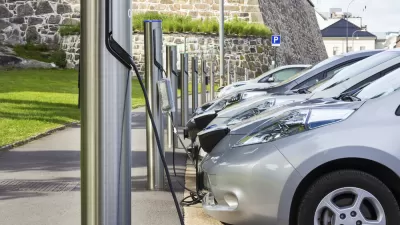Last week I attended the NREL Energy Analysis Forum, where leading North American energy analysts discussed current thinking concerning greenhouse gas emission reduction strategies, much of which involves emission cap and trade programs (as summarized in the report by Resources for the Future, "Key Congressional Climate Change Legislation Compared"). Similarly, a recent report, "Reducing U.S. Greenhouse Gas Emissions: How Much At What Cost" evaluates emission reduction strategies according to their cost effectiveness.
Last week I attended the NREL Energy Analysis Forum, where leading North American energy analysts discussed current thinking concerning greenhouse gas emission reduction strategies, much of which involves emission cap and trade programs (as summarized in the report by Resources for the Future, "Key Congressional Climate Change Legislation Compared"). Similarly, a recent report, "Reducing U.S. Greenhouse Gas Emissions: How Much At What Cost" evaluates emission reduction strategies according to their cost effectiveness.
Virtually all this analysis is biased against mobility management (strategies that increase transport system efficiency by improving accessibility options and applying more efficient incentives), for the following reasons:
* Co-benefits are ignored. Current analysis gives little consideration to benefits such congestion reduction, road and parking facility cost savings, consumer savings, reduced traffic accidents, and improved mobility for non-drivers, although these benefits are often larger in total value than emission reduction benefits. When all impacts are considered, mobility management strategies are often among the most cost effective GHG emission reduction strategies, because they are justified on economic grounds and so provide "free" environmental benefits.
* Current analysis generally ignores the additional external costs that result when increased vehicle fuel efficiency and subsidized alternative fuels stimulates additional vehicle travel, called a "rebound effect."
* Mobility management emission reductions are considered difficult to predict. Although case studies and models are available for many of these strategies, this information is not widely applied to energy planning.
* Mobility management programs are considered difficult to implement. Such programs often involve multiple stakeholders, such as regional and local governments, employers and developers, and various special interest groups. As a result, they tend to seem difficult and risky compared with other emission reduction strategies that only require changes to utility operations, fuel production or vehicle designs.
* Analysis often assumes that vehicle travel reductions harm consumers and the economy. In fact, many mobility management strategies benefit consumers directly and increase economic productivity. Our research, summarized in the report "Socially Optimal Transport Prices and Marekts" indicates that with more optimal pricing and planning practices, travelers would choose to drive less, use alternative modes more, and be better off overall as a result.
Described differently, there are two general approaches to reducing transportation emissions: reduce emission rates per vehicle-kilometer or reduce total vehicle-travel. The first often seems easier, but if done correctly, the second provides far more benefits and so is often best overall.
Currently proposed emission reduction programs (particularly those that rely on cap-and-trade) will not implement mobility management as much as optimal, and will miss an opportunity to help address other planning objectives, such as congestion reductions, crash reductions, consumer savings and improved mobility for non-drivers. It is up to people who understand the wider value of mobility management to educate energy analysts about these issues, so mobility management can receive the support justified.

Maui's Vacation Rental Debate Turns Ugly
Verbal attacks, misinformation campaigns and fistfights plague a high-stakes debate to convert thousands of vacation rentals into long-term housing.

Planetizen Federal Action Tracker
A weekly monitor of how Trump’s orders and actions are impacting planners and planning in America.

In Urban Planning, AI Prompting Could be the New Design Thinking
Creativity has long been key to great urban design. What if we see AI as our new creative partner?

King County Supportive Housing Program Offers Hope for Unhoused Residents
The county is taking a ‘Housing First’ approach that prioritizes getting people into housing, then offering wraparound supportive services.

Researchers Use AI to Get Clearer Picture of US Housing
Analysts are using artificial intelligence to supercharge their research by allowing them to comb through data faster. Though these AI tools can be error prone, they save time and housing researchers are optimistic about the future.

Making Shared Micromobility More Inclusive
Cities and shared mobility system operators can do more to include people with disabilities in planning and operations, per a new report.
Urban Design for Planners 1: Software Tools
This six-course series explores essential urban design concepts using open source software and equips planners with the tools they need to participate fully in the urban design process.
Planning for Universal Design
Learn the tools for implementing Universal Design in planning regulations.
planning NEXT
Appalachian Highlands Housing Partners
Mpact (founded as Rail~Volution)
City of Camden Redevelopment Agency
City of Astoria
City of Portland
City of Laramie





























